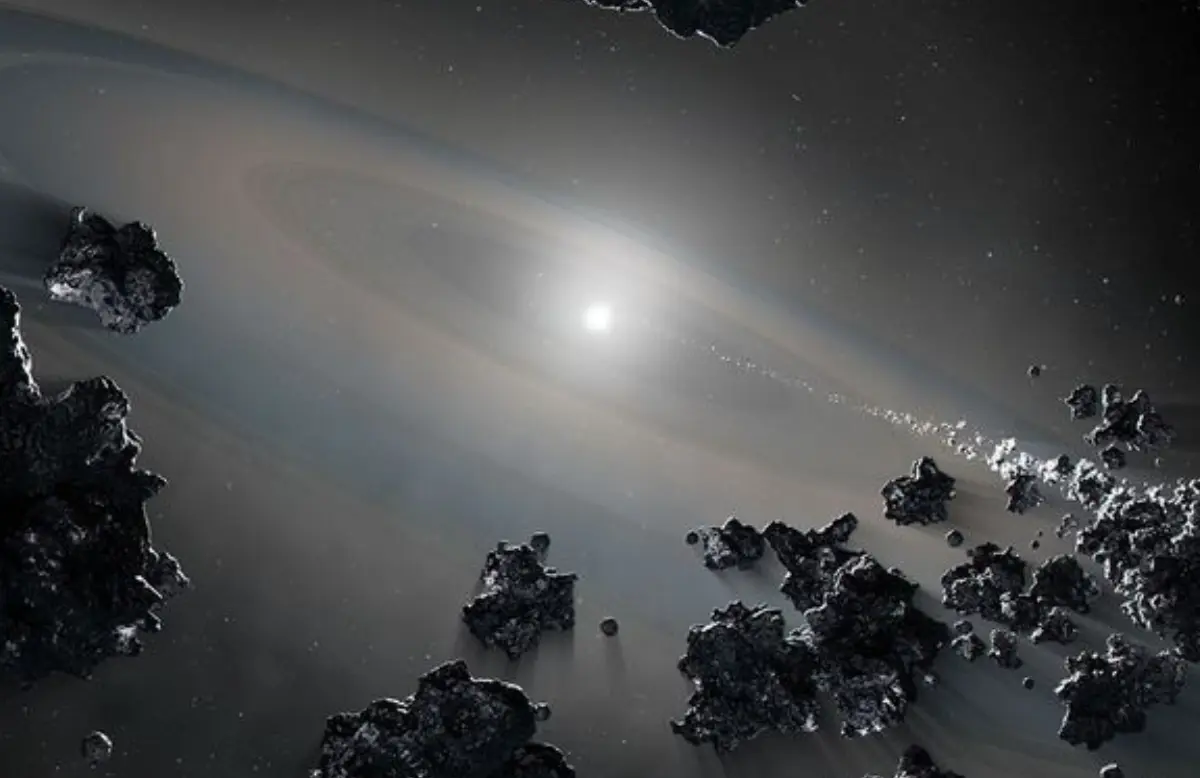Astronomers find a 3-billion-year-old white dwarf system that remains active long after its star’s death
-
 Illustration of a white dwarf star siphoning off debris from shattered objects in a planetary system (Image via NASA)
Illustration of a white dwarf star siphoning off debris from shattered objects in a planetary system (Image via NASA)Astronomers have identified a white dwarf system, LSPM J0207+3331, that continues to accrete material from its former planetary system 3 billion years after the star’s death, as reported by Universe Today.
Located 145 light-years from Earth, the system was observed using the W. M. Keck Observatory on Maunakea, Hawaii.
Spectroscopic analysis obtained by the research team revealed 13 chemical elements, including sodium, magnesium, aluminum, silicon, calcium, titanium, chromium, manganese, iron, cobalt, nickel, copper, and strontium.
According to the publication in The Astrophysical Journal Letters on October 22, these elements originated from a differentiated rocky body that was disrupted by the star’s gravity, forming a debris disk around the white dwarf.
3-billion-year-old white dwarf system shows ongoing planetary accumulation
Detection of heavy elements
The research team used the High Resolution Echelle Spectrometer (HIRES) on the Keck I telescope to obtain detailed spectra of LSPM J0207+3331, according to Universe Today.
The spectra confirmed that the minerals came from a rocky body at least 200 kilometers in diameter.
These elements were detected in the hydrogen-rich envelope of the white dwarf, a feature that typically conceals heavy elements in other systems.
The international team of astronomers, including members from the Trottier Institute for Research on Exoplanets, Université de Montréal, the Centre de Recherche en Astrophysique du Québec, Carnegie Institution for Science, Gemini Observatory/NOIRLab, and the Space Telescope Science Institute, reported that ongoing accretion is present in this ancient white dwarf.
Dynamical activity after stellar death
As per Universe Today, the system shows evidence of recent dynamical disturbances that likely caused the rocky body to spiral inward toward the white dwarf.
The amount of material that was piled up points to a fairly recent time, i.e., a few million years, when the disruption happened.
The scientists concluded that late instability which may be due to interaction between several planets can very slowly change the orbits in a region unstable over billions of years.
According to John Debes from the Space Telescope Science Institute, the system has a source of material that can go on with accretion and tidal disruption for quite a long time after the star has left its main sequence phase.
Future observations and planetary search
Scientists are looking forward to examining the cause of the possible disturbance, which might be a Jupiter-like planet revolving around LSPM J0207+3331.
In fact, finding a planet of that kind would be all about witnessing how its gravity affects the white dwarf since the planet itself would be hardly visible.
The European Space Agency’s Gaia Observatory may detect outer planets indirectly, and NASA’s James Webb Space Telescope could provide infrared observations to locate planetary bodies within the system.
Continued observation aims to document how planetary remnants remain active around white dwarfs over billions of years.
Significance of the system
Universe Today details that LSPM J0207+3331 is classified as a polluted white dwarf, a category that includes stars surrounded by clouds of material from former planetary systems.
About white dwarfs that were looked at, approximately 50% of them have signs of heavy-element accretion but these elements are mostly concealed by hydrogen-rich atmospheres.
Such a finding of material in a system aged 3 billion years serves as a proof of ongoing dynamical interaction with planetary remnants over a very long time and, thus, adds to the knowledge of the fate of planetary systems after the death of a star, as per the international team of researchers' report in The Astrophysical Journal Letters.
The chemical makeup of the disk of debris around LSPM J0207+3331 is a way for astronomers can also get the mineralogical study of extraterrestrial material after the star has stopped fusion.
Stay tuned for more updates.
TOPICS: White dwarf, Ancient star system, High Resolution Echelle Spectrometer HIRES, LSPM J0207+3331, Polluted white dwarf, White dwarf accretion/infall, White dwarf planetary system